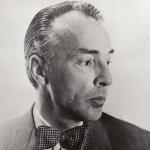
On 23 July at the Mariinsky-II a ballet evening will mark 110 years since the birth of George Balanchine. The programme for the evening includes the ballets Serenade, Apollo and Symphony in C.
Today, his choreography is danced everywhere and playbills of theatres throughout the world are adorned with the phrase “produced in accordance with the Balanchine Style® and Balanchine Technique® service standards”. Indeed, fame and glory came to the choreographer during his own lifetime.
And, it would appear, everything he achieved he achieved with ease. In his youth – while he was a dancer starting out at the Mariinsky Theatre – he wished to seek out new forms in dance and established the Youth Ballet group from recent graduates of the Theatre School, staging his very first productions for them. In the mid 1920s destiny would take him from cold and hungry Petrograd to join Diaghilev’s successful European company. And then it was kind enough to throw him into the path of Lincoln Kirstein who invited him to come and enchant New York. Dancers were needed across the ocean – Balanchine trained them and established both a school and an amazing company with its own unique repertoire. And he won the heart of not just America but the rest of the world as well.
Having been educated to preserve and being a witness of the development of Fyodor Lopukhov’s ideas about symphonism and choreography, Balanchine was drawn by the nature of pure dance subjected to the laws of development of musical form. While many dancers and choreographers were convinced that classical dance had exhausted its possibilities, it was with ease that Balanchine demonstrated its vitality and gave it new life, rejecting superfluous emotionality and psychology that overshadowed the crystal purity of form. Even those who, not accepting the plot-less ballet, criticised Balanchine “for formalism” were won over by the light breath of his art in which there were no human passions behind the dance, there was just the music, its rhythm and structure determining the development of the dance image.
The desire for lightness could be sensed in everything – in the rejection of plots in ballets and the creation of dance that corresponds only to the music; in the preference of minimalism in costumes and the rejection of sets (with rare exceptions). All of Balanchine’s productions are imbued with the light of the love of life; there is a parody of variety show girls in Western Symphony, there is competitiveness among the professional dancers in Agon and there is the romanticism of youth and the mysterious wonder of a moonlit night in the refined choreographic structures of Serenade. Preferring not to have a plot, the choreographer nevertheless created ballets with plots with the same effortlessness, brilliantly condensing in one act all the peripeteia of the tale in A Midsummer Night’s Dream or the libretto of Swan Lake. The desire for lightness (meaning memories here) also came with a rejection of the “extra” letters of a cumbersome name: from Balanchivadze to Balanchine and then simply to Mr B.
Freedom in principal in art from everything that is not essential, a love of life and “lightness of life” – these are the things, it would appear, that draw the portrait of a practical American with the broad smile of the eternal optimist and the faithful companion of success. But Balanchine never counted on its favour and never relied on anything other than his own profession. Unlike practical Americans, Balanchine did not care about the future of his productions and he didn’t worry about them being danced by several generations. And they are danced, people take pride in them, people dream of them... Yet the choreographer did not consider himself an American – he said that by blood he was Georgian, by culture he was Russian and by nationality he was a Petersburger.
Olga Makarova